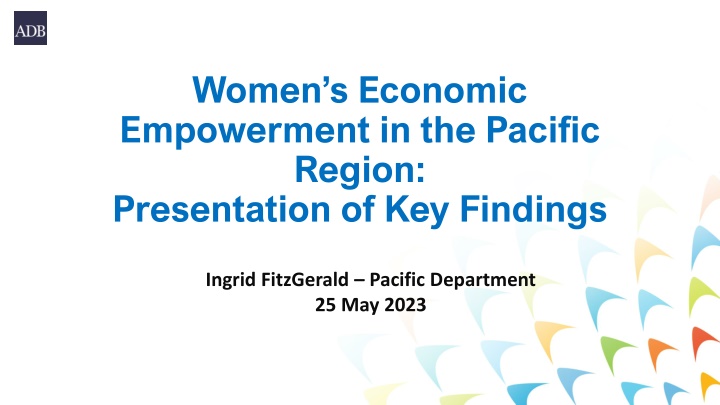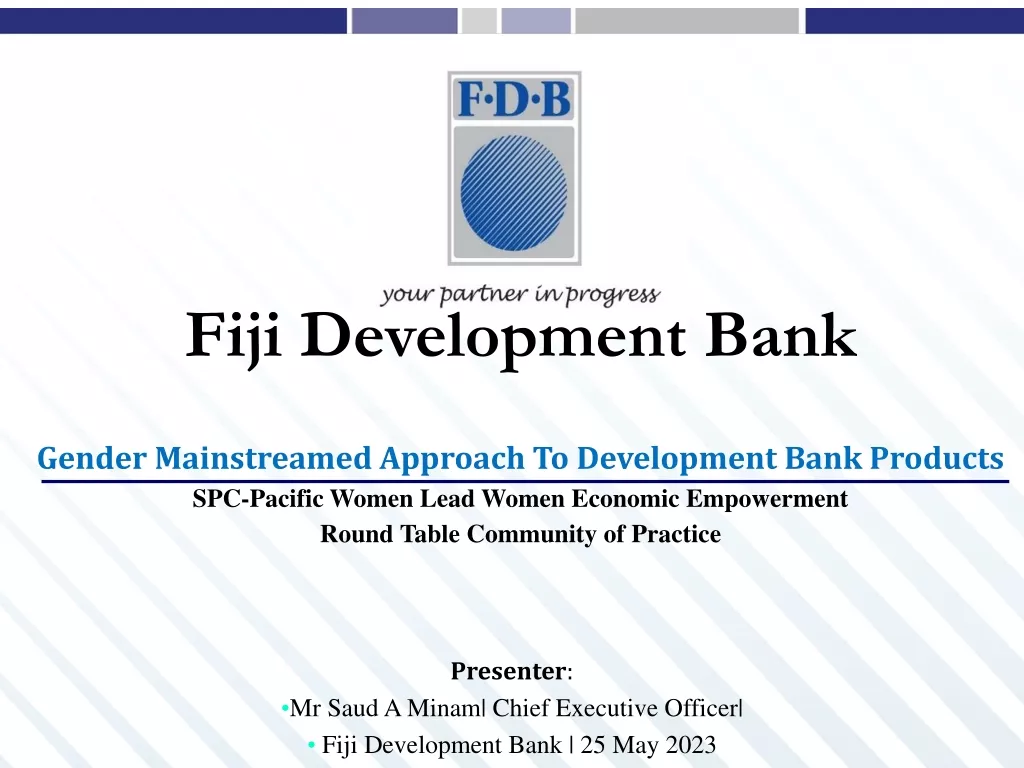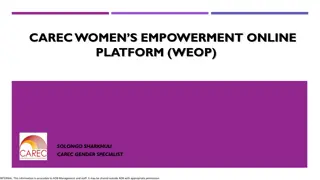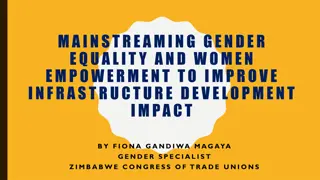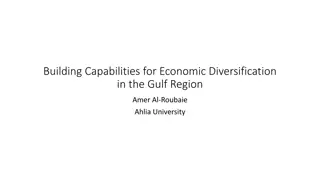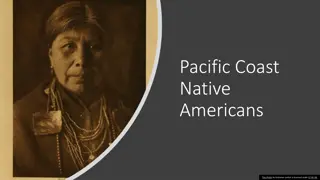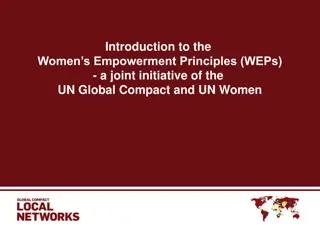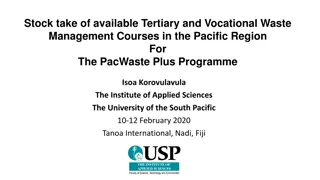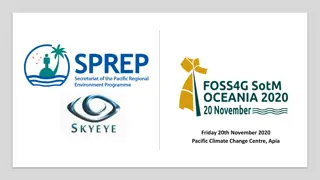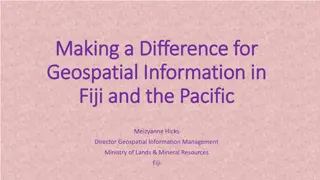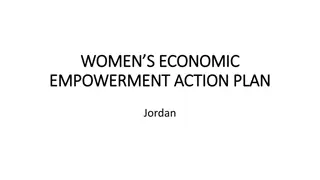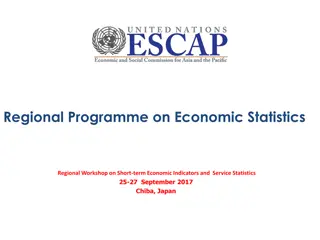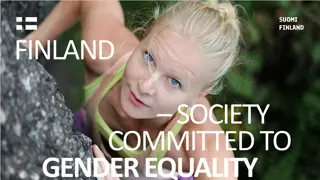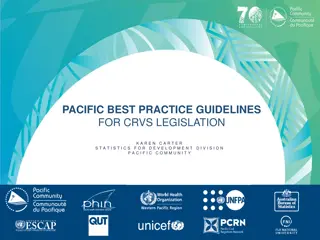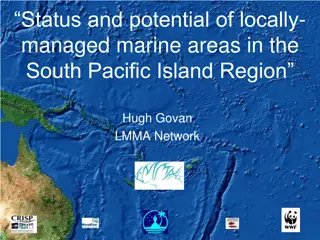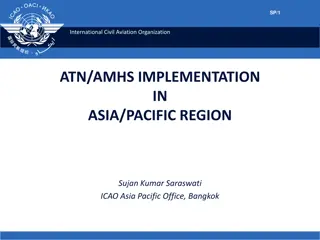Women's Economic Empowerment in the Pacific Region: Key Findings
Women in the Pacific face challenges in economic empowerment due to low labor force participation, poor working conditions, limited decision-making power, and legal barriers. They carry a disproportionate burden of unpaid work, lack access to childcare and job opportunities, and face obstacles in accessing assets and services. Pacific women also have lower digital technology access and are more vulnerable to climate change impacts.
Download Presentation

Please find below an Image/Link to download the presentation.
The content on the website is provided AS IS for your information and personal use only. It may not be sold, licensed, or shared on other websites without obtaining consent from the author.If you encounter any issues during the download, it is possible that the publisher has removed the file from their server.
You are allowed to download the files provided on this website for personal or commercial use, subject to the condition that they are used lawfully. All files are the property of their respective owners.
The content on the website is provided AS IS for your information and personal use only. It may not be sold, licensed, or shared on other websites without obtaining consent from the author.
E N D
Presentation Transcript
Womens Economic Empowerment in the Pacific Region: Presentation of Key Findings Ingrid FitzGerald Pacific Department 25 May 2023
Presentation Overview Methodology Key Findings Current status and trends in women s economic empowerment in the Pacific. Women and women-owned businesses in the informal economy. Impact of the COVID-19 pandemic on women owned businesses. Recommendations
Methodology Women s Economic Empowerment: Conceptual Framework Methodological approach Stage 1: Scan 11 quantitative databases 200+ publications Assets, services, networks, and opportunities Enabling environment Literature covered from 2010 onwards, in English language, peer-reviewed and grey literature. Stage 2: Evidence Mapping Literature coded into an Excel matrix template, with columns correlated to research questions. Stage 3: Report Writing Evidence synthesized under each research question. Women s voice and agency Source: Calder (2019) cited in Hearle et al. (2020).
Current status and trends in womens economic empowerment in the Pacific Women s labor force participation remains low, varying from 84% in Solomon Islands to 34% in Samoa (World Bank 2021). Women face poor working conditions, risks of sexual harassment and abuse, limited collective bargaining voice and are more likely to live in poverty. Women have less decision-making power than men. Women hold 21% of board seats, 11% of board chair positions and 13% of CEOs (PSDI 2021). Many Pacific Island countries have laws protecting women s rights, but legal and policy gaps and barriers persist. Many women are excluded from inheritance rights to customary lands. Laws mandating equal pay for work of equal value and prohibiting sexual harassment at work are the least enacted.
Current status and trends in womens economic empowerment in the Pacific Women carry an unequal burden of unpaid domestic and care work. Access to affordable and quality childcare is a key barrier for women and working parents. Unequal access to training, job opportunities and finance. Access to assets, finance and services is limited by sociocultural norms. Productivity is lowered by poor infrastructure coverage and maintenance, particularly for women in remote areas. Pacific women, especially those in remote areas, have lower levels of access to digital technology than men despite strong evidence of its potential to improve business outcomes. Pacific women are more likely to experience the negative effects of climate change and less likely to have access to resources and information to adapt and respond.
Women and women-owned businesses in the informal economy Women predominate in the informal economy, particularly in remote areas. Women are concentrated in subsistence agriculture and fishing, as market vendors, producing garments and handicrafts, in low productivity jobs with limited start-up capital required and limited skill accumulation potential. Even within sectors, occupational segregation of informal work exists, and women earn less income than men. Women tend to work in the lower segments of the informal work hierarchy as homeworkers and unpaid family workers.
Women and women-owned businesses in the informal economy Women s entrepreneurship is common in the Pacific region. Female ownership remains most prevalent in family-run, smaller, and informal firms. Women s businesses are disproportionately represented in informal and MSME sectors. 90.2% of Pacific women-owned MSMEs are in the informal sector. In Samoa, almost all women-owned MSMEs are in the informal sector The percentage of women-owned micro- firms ranges from 9% in Fiji to 66.3% in Tonga. Most Pacific island countries have between 40% and 49% of micro-sized firms owned by women. Women-owned businesses are concentrated in industries that experience intense competition and generate lower returns, in agriculture and in the services sector in retail, restaurants, hospitality and tourism, and handicrafts.
Women and women-owned businesses in the informal economy Reasons for remaining in the informal economy Flexibility in managing multiple responsibilities, including unpaid care work. Compliance costs associated with labour regulations, taxes, and license fees. Lack of awareness of the formalization process. Limited access to regulatory authorities in remote areas. Difficulties in accessing opportunities and markets due to geographical remoteness and lack of infrastructure. Demands from family and community for money when in paid work. Barriers to expansion and formalization Social norms and cultural expectations. Limited access to commercial finance and collateral due to undocumented income and land ownership issues. Lack of financial expertise. Research by Pacific Private Sector Development Initiative in Papua New Guinea found that women are 25% less financially literate than men. Difficulty in accessing justice system and resolving commercial disputes.
Women and Women-owned Businesses in the Informal Economy Enabling Environment Weak enabling environment for promoting business and entrepreneurship disproportionately impacts women. Women in business are less likely to be consulted for their views in legislative and reform processes. Digital processes are the most widely cited positive change in the enabling environment, for example, women can apply for a business license via traditional paper-based forms or through an online system. Emerging evidence of the potential benefit of gender-responsive procurement but few countries have policy or legislative frameworks that explicitly support or actively promote it.
Impact of the COVID-19 Pandemic on Women s Businesses in the Pacific Women-owned MSMEs have been worse affected by the pandemic than male-owned businesses, especially those which are newer and have less than 5 employees. There is mixed evidence on the effects of COVID-19 on women entrepreneurs and workers in the informal economy. Women entrepreneurs experienced increases in unpaid care work. COVID-19 worsened pre-existing gendered barriers in access to finance for women entrepreneurs. During the pandemic, women owned businesses were more likely to need financial support.
Impact of the COVID-19 Pandemic on Women s Businesses in the Pacific Women-owned MSMEs struggled to access COVID- 19 government support packages. There were promising examples of regional COVID- 19 support for women entrepreneurs e.g. through one-off payments, though these were often insufficient, to meet their needs, and evidence is not available on their impact. Govt. stimulus packages for women-owned MSMEs focused on credit, thereby excluding the many women-owned businesses in the informal economy.
Recommendations Research Research women s economic empowerment status and trends for women from groups that have historically been marginalized, such as vulnerable informal workers and people with disabilities (for example, we know a lot of women with disabilities work in the informal sector). We know very little about the informal sector compared to other sectors. Effectiveness of government stimulus and crisis support packages aimed at women- owned businesses and women entrepreneurs, particularly in the informal sector. Further research into social protection options for workers in the lower segments of the informal economy, including women- owned informal MSMEs.
Recommendations Policy and Regulation Regulators, such as central banks or banking authorities, require sex- disaggregated data to be collected, publicly released, and reported, particularly for women in the informal sector. Encourage financial service providers to use data to design new products for women. Reform tax, finance, and licensing policies and systems to remove barriers and disincentives for women-owned businesses to formalize. Promote legal recognition of informal workers and widen the coverage of social protection systems to enhance the entitlements of informal workers and entrepreneurs. Introduce childcare policies to help women manage their own business in the informal economy, or want to return to, or stay at work after having children.
Recommendations Programs Develop the unpaid and paid care provider economy and infrastructure, such as supporting quality and affordable care services, including coverage for informal workers. Develop and implement targeted measures to help self-employed women restart their businesses that collapsed or are in survival mode because of pandemic and/or crises associated challenges. Explore the use of digital technologies to enhance business outcomes for women and expand this to women in the informal sector. Encourage financial institutions to accept non- land assets as collateral and increase uptake of secured transaction frameworks and build on good practice and experience in the Pacific. Work with banks to adjust their risk assessment criteria in favour of MSMEs and informal businesses.
